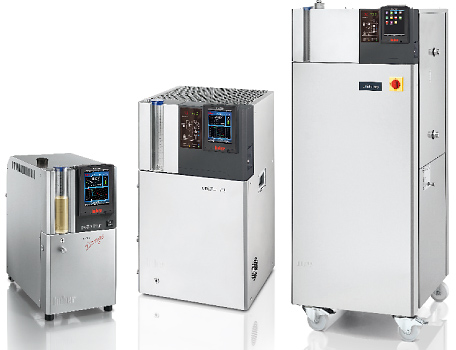Unistats – unique thermodynamics for laboratory, pilot plant and production
Unistats® are not comparable with conventional temperature control engineering.
There are no alternatives thermodynamically.
Our engineers know what you require from research and production: PROCESS SECURITY! The security that the temperature-dependent processes in your laboratory and in the production will run exactly as you want them to – without making compromises – at any time. Unistats give you the pleasant feeling of being thermodynamically on the safer side.
You need precise and reliable control of all of their thermodynamic parameter for them to be successful, so that you can reach your goal without making compromises. We therefore place a great deal of emphasis on ensuring that our Unistats deliver exactl what you need: PROCESS STABILITY in the high end Quality!

The thermoregulation task is always in the forefront
The most up-to-date pump technology and optimal recirculation increase the throughflow quantities and lead to a significantly improved heat transfer on the object. Predicatable and reproducible results and previously unachieved change speeds for the temperature curve deliver a significantly improved Return on Investment (ROI), which is additionally improved by the minimised operating costs of the Unistat principle. Also the Unistat principle has not changed significantly since 1988 because it has proven itself so well in practice.
Conventional bath and circulation thermostats operate hydraulically with an open bath
In the case of open thermostatic baths (Picture 1), whether temperature control occurs internal (A) or external (B) the bath fluid is not sealed off from the atmosphere, that is it is open and not under pressure. In the case of external temperature control (B) the level of the bath has be controlled on both sides. In the case of the typical external closed temperature control (Picture 2), where the object comes directly (D) or indirectly (C) in contact with the thermostat medium, the thermostat bath which is open to the atmosphere is also, at the same time, to expansion vessel for volume changes occurring due to thermal changes.

Unistats® embody performance and dynamism. Small in size but large in performance.
The Unistat System (Picture 3) combines the possibilities arising from effective thermodynamics and intelligent microelectronics. In this way a comprehensive alternative to previously known temperature control engineering was developed. Unistats are circulation thermostats without a temperature control bath. An expansion vessel replaces the conventional bath for volume changes occurring due to thermal changes for externally connected systems. To temperature control open baths (F) it is simply necessary to block off the expansion vessel. The Unistat is therefore hydraulically sealed and can be located under the table without incurring any level problem. This principle reduces to masses to be temperature controlled and therefore increases the speeds for the temperature change. Unistats have the smallest possible own masses and therefore can achieve cooling speeds of a number of hundred Kelvins per hour. It is appropriate to cast an eye on the cooling performance density [Watt/Liter] according to DIN 12876 to compare the dynamism.

Advantages in practise
The thermodynamic properties of Unistats are very different from those of temperature control systems from other manufacturers. In practise there are therefore concrete advantages which arise in your work: tangibly shorter heating up and cooling down times, improved stability and reproducibility of the whole processing chain, more security for expensive glass reactors and the substances contained in them as well as simple, comfortable operation.



